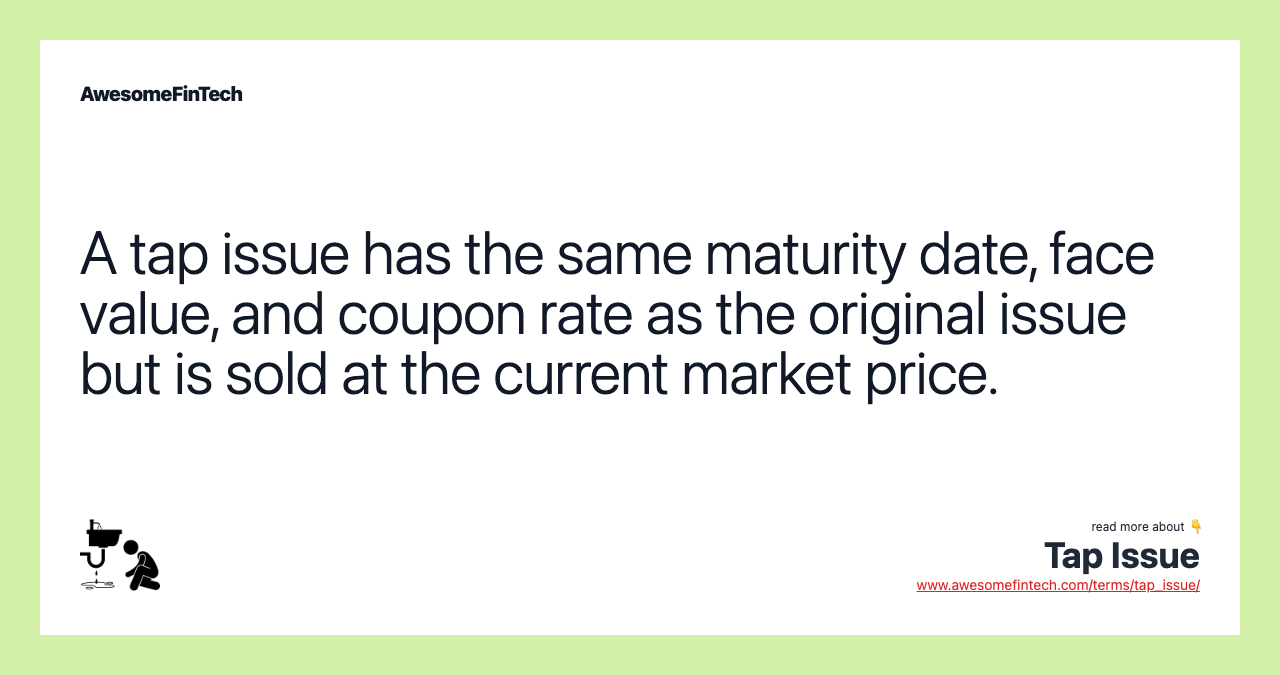Tap Issue
A tap issue is a procedure that allows borrowers to sell bonds or other short-term debt instruments from past issues. The bond tap is sold at the current market value on their issuance dates but issued under the same terms — face value, maturity date, coupon rate — as the initial series of bonds. A tap issue has the same maturity date, face value, and coupon rate as the original issue but is sold at the current market price. A tap issue is also referred to as a bond tap or tap sale. A tap issue is when a portion of a bond issue is held back after it is initially authorized and later made available to the public.

What Is a Tap Issue?
A tap issue is a procedure that allows borrowers to sell bonds or other short-term debt instruments from past issues. The bonds are issued at their original face value, maturity, and coupon rate but are sold at the current market price. A tap issue is also referred to as a bond tap or tap sale.



How a Tap Issue Works
When a bond is issued, it is made available in the public markets for lenders and investors to purchase. However, before a bond can be issued, it has to be authorized by the issuer. Sometimes, a portion or the full amount of the bond that is authorized is held back until the issuer needs the funds that the bond will provide when sold. When the bond is issued to the public at a later date, it is referred to as a tap issue.
Tap issues, which help avoid transaction and legal costs, are ideal for smaller fundraising attempts, where fundraising can be cost-prohibitive.
Benefits of a Tap Issue
A tap issue is usually a government security, such as a Treasury bill. The borrowing issuer announces the availability of the issue and accepts bids for a specified time period. The issue is sold at a fixed price or for a price dependent on the demand for the debt instrument. If the price is fixed, the security's price will not appreciate in the secondary market and, thus, the issuer will be stuck paying a higher yield than would otherwise be necessary.
With a tap issue, the borrowing governmental body issues bonds over a period of time, rather than in one auction sale. A tap issue allows the government to make the bond available to investors when market conditions are most favorable. It is also an attractive mechanism for issuers as it provides for timely access to funds.
The bond tap is sold at the current market value on their issuance dates but issued under the same terms — face value, maturity date, coupon rate — as the initial series of bonds. Since the bond is priced at its market value, an issuer is able to offer the bonds at a premium to par if the bonds are trading attractively on the open market. And since a premium bond has a lower yield compared to a discount bond, the borrowing issuer will be in an advantageous position as it would be paying a lower return to investors.
Furthermore, by offering a bond with the same terms as its initial series, the issuer can lock in covenants, redemption schedules, and interest payment dates.
Special Considerations
This method of issuing additional debt was adopted by the British and French governments. Tap issues allow an organization to avoid certain transactional or legal costs and expedite fundraising. The issuer bypasses many of the initial formalities surrounding a bond issue, such as the prospectus, and proceeds to auction off the new securities. Issuing on tap is often suited for smaller fundraising attempts, where the cost of a new issue is too high when compared to the amount borrowed.
Related terms:
Agency Security
An agency security is a low-risk debt obligation that is issued by a U.S. government-sponsored enterprise (GSE) or other federally related entity. read more
Bond Covenant
A bond covenant is a legally binding term of an agreement between a bond issuer and a bondholder, designed to protect the interests of both parties. read more
Bond Yield : Formula & Calculation
Bond yield is the amount of return an investor will realize on a bond, calculated by dividing its face value by the amount of interest it pays. read more
Bond : Understanding What a Bond Is
A bond is a fixed income investment in which an investor loans money to an entity (corporate or governmental) that borrows the funds for a defined period of time at a fixed interest rate. read more
Bond Market
The bond market is the collective name given to all trades and issues of debt securities. Learn more about corporate, government, and municipal bonds. read more
Current Market Value (CMV)
The current market value is the present value of a financial instrument, which can be the closing price or the bid price depending on the item. read more
Coupon Rate
A coupon rate is the yield paid by a fixed income security, which is the annual coupon payments divided by the bond's face or par value. read more
Face Value
Face value is the nominal value or dollar value of a security stated by the issuer, also known as "par value" or simply "par." read more
Fixed Income & Examples
Fixed income refers to assets and securities that bear fixed cash flows for investors, such as fixed rate interest or dividends. read more
Intermediate/Medium-Term Debt
Medium-term debt is a type of bond or other fixed income security with a maturity, or date of principal repayment, that is set to occur in two to 10 years. read more